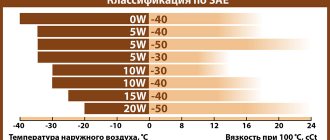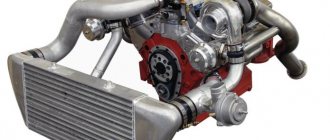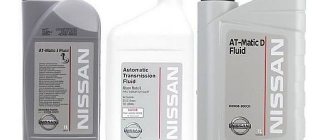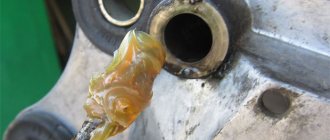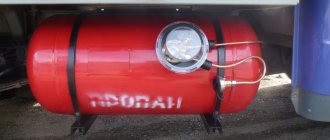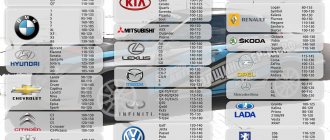Changing the oil in the rear axle gearbox on a VAZ 2101-VAZ 2107
Oil in the gearbox The whole mechanism that spins and rubs against each other needs oil, the same goes for the gearbox, inside it there are gears (They are iron) that rub against each other during operation and if they are not lubricated with anything, they will quickly come out (They will develop snags or become completely deformed and the gearbox will have to be replaced), and when lubricated, they will spin and rub against each other with even less friction, and therefore the wear of the parts will be reduced (They will not fail so quickly) In addition, the gears in the gearbox will also work more quietly and thus it will not hum and vibrate very much, as it will if you completely drain the oil and start the car.
To change the oil you need a minimum of tools and a minimum of time, so here are the tools that will come in handy: A wrench of approximately “17”, and also stock up on a hexagon of about “12”, so a cloth will come in handy to clean the drain plug from all the dirt, well and the oil itself, by the way, about 1.3 liters of transmission oil goes into the gearbox (take a container for draining about 2 liters, or in general you can substitute a basin, it’s just not convenient to drain the oil into a small container)!
Where is the rear axle gearbox located?
It is located in the rear central part under the bottom of the car, there is also a cardan transmission (some people call it a driveshaft) passes and is connected to this very gearbox, in the photo below you can clearly see the gearbox because it is circled, there are two more plugs on it are necessary just for filling the oil (This is the filler plug indicated by a reddish arrow) and for draining it (This is the drain plug indicated by a blue arrow), remember them right away, since as you read the article we will not indicate them in the photo, but simply tell you to unscrew the filler plug, turn off the drain, because you need to know their location.
When do you need to change the oil in the rear axle gearbox?
There is no specific threshold for changing the oil, because different manufacturers have different properties, some claim that the oil never needs to be changed (There are a lot of statements about the fact that the oil
no need to change, as for the control gearbox, in fact, everything wears out over time and must be replaced) but each oil has additives, thanks to which the gears wear out less, and their anti-corrosion characteristics are included so that the gears do not rot, therefore after a certain threshold the oil 100% will have to be changed, as for
the rear axle gearbox
, the oil in it is replaced every 20,000-40,000 thousand km.
mileage, depending, as we have already said, on the properties of the oil, in addition to the operation of the car (Where it drives) you also need to look, for example, if you live in a rural area where there is only dust and dirty road surfaces on which you have to skid in the rain, then the oil
in this case, it is necessary to change more often, the same applies to cars that drive and brake for a short distance and then move again (In the city, many cars drive like this, stuck in traffic jams all the time) and the oil becomes unusable most quickly when driving at high speeds ( Since the engine turns a lot of revolutions there) and when pulling various kinds of trailers.
How to change the oil in the rear axle gearbox on a VAZ 2101-VAZ 2107?
1) Firstly, the oil needs to be warmed up, because heated oil flows out faster, and also all the dirty particles from the inside of the gearbox housing flake off and mix with the oil, then you will pour out all the oil and all the dirt that is on the walls of the gearbox housing (Gearbox housing this is where the oil is located), in order to warm up the oil, start the car’s engine and let it run for some time, when the engine temperature arrow shows the operating temperature, finish warming up and turn off the car’s engine, at this moment the oil in the gearbox will heat up to a fairly high temperature temperature (Approximately 75-90 degrees), so be careful when you drain it so you don’t get burned.
2) Now stock up on some kind of iron brush and use it to wipe the filler plug and drain from dirt, you don’t have to do this, but if you have a brush at hand, then follow the advice, after this operation, unscrew the drain plug and when you feel that the plug is already there Once it’s unscrewed, put the hex key aside and unscrew this same plug by hand as shown in the photo below, keep in mind that after you unscrew the plug, oil will flow out of the hole it covers, so immediately prepare an empty container for draining.
If you want to more thoroughly pour out all the oil and all the dirt from the gearbox, then slightly lift the right rear part of the car with a jack, then the car will fall onto the left side (In the direction of travel of the car) and all the oil will better drain out of the gearbox, because the drain holes are located not directly at the bottom, but a little on the side (you can see this in the small photo below)!
Monitoring and maintenance at stations
2.1. at intermediate stations and turnover stations
Train maintenance personnel must carry out an external inspection of the gearbox from the middle part of the axle.
Particularly ensure that
- all fastening bolts and their locking elements were present
- the external condition of the gearbox from the middle part of the axle, the cardan shaft and the safety device and the elastic coupling was in order
- There were no oil leaks at the points where the shafts exited the gearbox. If there is an oil leak, you should check the oil level and, if necessary, add it to a level where the oil covers the measuring mark on the filler plug (Fig. 5).
If there are no signs of malfunctions listed in the “Troubleshooting” section, the gearbox is not considered defective and continues to be used.
- If gearbox malfunctions are detected while driving, you should check especially carefully and follow the instructions in the “Troubleshooting” section.
ATTENTION! If, during an external inspection, defects affecting the performance of the gearbox are identified, it is necessary to make a decision on the possibility of further operation of the passenger car.
2.2. at train stations
Carry out inspection and maintenance as specified in clause 2.1.
The following is subject to additional verification:
- oil level,
- all mounting bolts (tightness). If necessary, tighten them and secure them again. Replace faulty locking elements with new ones.
ATTENTION! The further operation of passenger cars equipped with gearboxes with detected defects, the immediate elimination of which is impossible, is prohibited. The formation of trains with such cars is permitted only after the defects have been eliminated.
When replacement may be needed
The lubricant loses its properties over time. The oil in the bridge must be changed regularly, according to the instructions. But during operation, signs of malfunctions may appear, which indicate the need for a faster change of waste fluid:
- appear from the side of the bridge;
- when the nature of the load changes, knocking noises become audible;
- There are drips and traces of oil fluid on the gearbox.
The car care instructions state that in the VAZ-2107 the rear axle oil is changed for the first time after running in (2000 km). And then it needs to be changed every 60 thousand kilometers. But, given the difficult climatic conditions with ultra-low temperatures, bad roads and constant driving in city traffic jams, it is recommended to fill in new oil after 30 - 35 thousand kilometers. Unscheduled maintenance when purchasing a used car, major repairs are also accompanied by the replacement of lubricant.
Experts advise changing the lubricant in different seasons (winter and summer). In winter, the oil composition should be more liquid, with a lower pour point. And in summer it is more viscous.
Selecting the right oil
It is important to choose the most suitable lubricant for a particular mechanism. This is due to the fact that there are worm gearboxes with a bronze worm, which require a lubricant with certain performance qualities. Among the features of the choice we include the following points:
- It is necessary to use only a special substance; it is not recommended to use the version for the motor, as it has other properties.
- Classification is carried out according to viscosity index, temperature conditions of use and many other parameters. The temperature regime is considered the most important, since it affects the properties. A low value may increase the density value; a high value leads to severe liquefaction and a decrease in characteristics.
- Many worm gear manufacturers indicate which design is most suitable. In some cases, this is a publicity stunt; you can choose another similar substance that will have the appropriate properties.
- Attention is also paid to the popularity of the lubricant manufacturer. The product of well-known brands is characterized by the fact that the declared indicators correspond to the real ones.
Oil change instructions
You can replace the gearbox lubricant in an inspection pit, overpass or lift. Before driving the car into the pit, you should drive a little and warm up the axle fluid. You should also prepare in advance a tool (a set of keys and screwdrivers), containers for working, protective gloves, rags, a special syringe or a device with a hose for pouring.
Changing the oil in the rear axle gearbox of the VAZ-2107 is performed in the following order:
- Clean the drain and filler plugs from any dirt.
- Using a 12mm wrench, unscrew the drain plug.
- Drain the old gear oil into the prepared container. Remember that the liquid will be hot after warming up.
- Tighten the drain plug.
- Unscrew the filler plug.
- Pour in enough oil to reach the bottom edge of the hole.
- Tighten the filler plug. Make sure there are no leaks.
If inspection of the used fluid shows severe contamination, then you need to rinse the gearbox before filling in a new one. To do this, mix transmission or motor oil with diesel fuel in a ratio of three to one. The resulting mixture is poured into the reducer. One wheel is lifted with a jack. The engine starts and first gear is engaged. This process takes several minutes. After this, the cleaning fluid can be drained and refilled with the drive axle.
Oil in the gearbox - all the mechanisms that rotate and rub against each other need oil, the same with the gearbox, inside it there are gears (They are metal) that rub against each other during operation and if they are not lubricated with anything, they will quickly come out (They will become scuffed or even deformed and the gearbox will have to be replaced), and when lubricated they will rotate and rub against each other with much less friction and therefore the wear of the parts will be reduced (They will not fail so quickly) , in addition, the gears in the gearbox will also work more quietly and thus it will not hum and vibrate too much as it will if you completely drain the oil and start the car.
How much to fill (volume)
You won’t believe it, but there are also owners who don’t even know that the rear axle of a car also needs regular lubrication, although not as often as the engine. Also, there are drivers who believe that if the oil does not expel or ooze, there is no need to change it at all. This is all wrong and it is also necessary to perform this procedure, as in the internal combustion engine and in the gearbox.
The lubricant volume should be 1.3 liters. To fill the required level, you need to wait until the oil flows from the filler hole; this will be considered the optimal volume.
Replacement
The oil is changed according to the same algorithm as the oil in the gearbox, after a mileage, so that the oil is hot and drains better:
- unscrew the filler plug
— place a container for used oil under the drain hole
- unscrew the drain plug
- after the oil has completely drained, tighten the drain plug
- pour oil into the filler hole until oil flows out of it
- tighten the filler plug
Which one to pour?
In terms of volume, 1.5 liters of liquid is sufficient for replacement. Change at intervals of 30-40,000 km or every 3 years, whichever comes first.
The most loaded unit in a VAZ 2107 car is the rear axle gearbox. But with proper assembly, installation and timely maintenance, it can last longer than even less loaded units. As the instructions indicate, the oil in the rear axle gearbox and gearbox should be changed after break-in, then after a run of two thousand kilometers and subsequently every sixty thousand kilometers. The design of the gearbox of a VAZ car uses a special type of hypoid transmission with offset axes. This engagement reduces the noise level when grinding surfaces, but the sliding that occurs along the contact line of the teeth can lead to the risk of jamming.
Using special gear oil in the gearbox can eliminate it. The mixture contains extreme pressure additives, class GL-5. This oil is called Hypoid.
The volume of oil poured into the gearbox is 1.35 liters. Changing the oil in the rear axle gearbox of a VAZ 2107 is carried out according to the same algorithm as the gearbox oil. Replacement must be made before operating the car in winter and summer. For these seasons, the oil has a different viscosity. In winter it is low, and in summer it is high.
When to change gear lubricant
Changing the oil in the rear axle of a VAZ 2107 should be done regularly, but there is no specific threshold. It all depends on many different factors, but the manufacturer of a domestic car recommends performing this procedure every 60 thousand km.
Some of the main factors that influence the timing of oil changes are:
- Driving character. Frequent and abrupt starts are not at all beneficial to the parts and mechanisms of the car, including the rear axle.
- Vehicle operating conditions. If the car is used in rural areas where there are poorly paved roads, dust, and dirt, then replacement should be done more often.
- Lubrication quality. It is recommended to fill the rear axle of the VAZ 2107 with special high-quality oil. If you pour low-quality lubricants into the gearbox, you will need to replace them much more often.
- Operating a vehicle with a trailer. The wear of the device parts will accelerate if the car is operated with a trailer in which cargo is transported.
Changing the oil in the rear axle gearbox of a VAZ
- There is silver dust in the mixture. If there are metal grains instead of dust, this indicates serious damage to the car. You can't get by with just an oil change.
- Coffee or black oil color. This indicates that water has entered it or the additives in the solution have been destroyed.
- You can change the oil in the VAZ 2107 axle gearbox yourself.
Tip: The oil should be drained after the car has been driven so that it is hot and drains well from the crankcase. But you need to be careful, the temperature of the liquid can reach 90 degrees.
Work order
So:
- Unscrew the plug in the hole for filling the oil with a key “17”.
- Place a container under the drain hole to collect used oil.
. - Use a hex wrench to “12” to unscrew the drain plug to remove the used oil.
- After the liquid has completely drained, the drain plug is screwed into place.
Advice: If the oil drained from the gearbox housing has a dark color or metal particles, the rear axle gearbox must be washed.
- To flush, you need to fill in about one liter of a mixture of thirty percent kerosene with gear oil. Instead of kerosene, you can use diesel fuel.
- One rear wheel is lifted, first gear is engaged and the engine is started.
- After three minutes, the washing mixture is drained.
- For filling, it is better to use an oil blower or a lever grease gun. If you don’t have them on hand, you can use a large plastic syringe with an elastic tube attached to its end.
- 1.3 liters of special transmission oil is poured into the gearbox.
- It is necessary to ensure that its level reaches the lower edge of the filler hole.
After filling the oil, the breather is checked and cleaned of dirt. This device is necessary in order to relieve excess pressure in the gearbox that is formed when the oil heats up and when its level rises. All operations for changing the oil on a VAZ 2107 car can be clearly seen in the video.
Oil for diesel walk-behind tractor: features of choice
When choosing engine oil for a diesel walk-behind tractor, you should follow the instructions in the operating instructions. However, if the instructions for use have been lost, then you will have to study the compositions available on the market more carefully.
Motor oils for diesel engines are classified into the following categories. The special markings indicated on the container with lubricant will help determine the type and compliance of the composition for a particular walk-behind tractor:
- API CJ-4 - compounds with this marking are designed specifically for walk-behind tractors with a capacity of 10 hp or more. With. and more. The composition of these lubricants has increased viscosity, which guarantees the proper operation of all elements of the unit’s motor;
- API CI-4 - these oils should be used for engines equipped with different types of injection and supercharging. Such oils have good dispersing characteristics and high resistance to thermal oxidation;
- API CH-4 - lubricants with this marking fully comply with all modern requirements and quality standards. Among the advantages of these compositions, one should highlight the ability to fill them into diesel engines running on fuel in which the sulfur percentage exceeds 0.5%;
- API CA - compositions of this type are optimally suited in cases where diesel fuel contains a small amount of sulfur. Oils with this marking protect the walk-behind tractor engine from the formation of harmful deposits on its walls;
- API CB - the use of oils of this oil reduces the risk of corrosion of walk-behind tractor bearings;
- API CC - such oils will be the best option for an engine equipped with a turbocharger, but without a supercharger. These compounds help walk-behind tractors withstand long-term loads and work properly in difficult conditions;
- API CF-2 - oils of this group perform well when used in walk-behind tractors that are subject to heavy loads.
After purchasing suitable motor oil, you can proceed to pouring it into the walk-behind tractor engine. The procedure for this is quite simple:
- First install the unit in a horizontal position;
- Place a wide container under the drain hole in the engine and remove the plug by carefully prying it off with a screwdriver;
- Wait until the old oil drains from the engine and screw the plug back into the hole;
- Pour at least 2 liters of new lubricant inside the engine.
Steering of a VAZ 2107 car
On the VAZ 2107 model, the steering has a safety design with an articulated-lever steering wheel drive and a worm-roller gearbox.
- The steering gearbox is secured with three bolts in the engine compartment on the left side member.
- An adjusting screw installed on the top cover of the gear housing can be used to adjust the gap in the engagement of the double-ridge roller and the worm built into the structure of the device.
- Approximately 0.2 liters of oil is poured into the steering gear housing.
- To fill the oil, there is a filling hole on the top cover of the gearbox housing. There is no hole for draining the oil; fluid is only added to the VAZ 2107 if necessary.
Oil fill volume (l)
| NMRV | 030 | 040 | 050 | 063 | 075 | 090 | 110 | 130 | 150 |
| VZ | 0.042 | 0.081 | 0.153 | 0.3 | 0.58 | 1.02 | 3,02 | 4,55 | 7,0 |
| AT 8 | 2,25 | 3,35 | 5,1 | ||||||
| B6, B7 | 2,55 | 3,55 | 5,4 | ||||||
| V5 | 3,02 | 4,55 | 7,0 | ||||||
| V6 | 3,02 | 4,55 | 5,1 |
WE RECOMMEND TO SUBSCRIBE TO THE CHANNEL
What kind of gasoline should I use?
This is the first problem that absolutely all scooter owners face. According to the passport, you need to fill it with an octane number higher than 90. In our area you can most often find 92 or 95. In principle, 92 will be enough (it contains the least amount of additives that “catch up” the octane number to the required one). The exception will be those scooters in which any gasoline below 95 is contraindicated, so it’s worth looking into your specific model once. Incorrectly selected gasoline can cause a number of problems: from contamination of the carburetor and fuel level sensor, and even to failure of the entire fuel system.
What kind of scooter oil?
2 stroke engine:
In a two-stroke engine, oil is dissolved in gasoline. The main task of which is to provide an oil film for rubbing parts and burn - leaving behind a minimal amount of combustion products.
You shouldn’t be “overthinking” with your choice. Among the relatively inexpensive oils, you can easily find fairly high-quality ones that can be safely refilled.
4-stroke engine:
When choosing oil for a four-stroke engine, you should consider:
- Scooter mileage
- Climate in which the engine will be used
- Engine speed
In the first case, if the engine resource is exhausted and the time for a major overhaul is approaching, experts recommend a mineral base and thicker oils.
I would combine the second and third options and draw the following parallel: if the engine constantly suffers from high speeds or temperatures, you should fill in a thicker lubricant product, which will retain its properties when heated. Conversely, “low-viscosity” oils are poured into engines with moderate climates and non-sporting characteristics. An undeniable advantage of such a lubricant will be its high penetration ability (penetration into metal at the molecular level). This property will give the motor of your scooter a longer life, and you will have a minimum of hassle with repairs.
All-season oils include those that are designated by two digits through W in the SAE classification.
Additives in oil:
In fact, there are not many types of additives used in the production of oils for 2 and 4 stroke engines. We can list a few:
Corrosion protection - special attention to protection during downtime, and naturally during operation. Protection against oxidation - we are dealing with the resulting property of the oil to neutralize the effects of high-temperature and chemical conditions on the lubricant
processes occurring inside the engine, preventing the oil from “aging” ahead of time
Protection against oxidation - we are dealing with the resulting property of the oil to neutralize the effects of high-temperature and chemical influences on the lubricant. processes occurring inside the engine, preventing the oil from “aging” ahead of time.
Reduced dispersion - saves rings from sticking by reducing the concentration of resins and, as a result, no contamination of spark plugs.
Neutralizer for high pressure and wear - includes a detergent additive that will contain burnt particles in suspension (preventing them from settling on the walls throughout the entire period of oil operation), adding strength to the oil film, thereby reducing friction.
Conclusion:
Based on the above (incomplete) list of additives used in two- and four-stroke scooter engines, we can conclude that adding additional additives is very unwise. There is only one reason - everything that the oil needed for good performance properties was included in the recipe class=”aligncenter” width=”402″ height=”414″[/img]
Advice:
Fans of 4-stroke scooters often use conventional automotive semi-synthetic SAE 10W-40 because... their formula is largely identical, the benefit is that there is no need to buy oils for different purposes for a car and separately for a two-wheeled pet.
To the engine
All cars of the brand are equipped with boxer power units, which are very demanding on the quality of engine oil. In addition, due to incorrectly selected lubricant, such a motor experiences so-called “oil starvation”. This phenomenon negatively affects its performance and causes overheating and increased wear of the main elements.
According to Subaru recommendations, for Forester 2.0 and 2.5 gasoline engines, with and without a turbine, an API class SH or SJ engine oil, marked “Energy Conserving II” (energy-saving II), or A2-96 (ACEA), is suitable. Viscosity:
- For the cold period - 5W-30,
- universal - 10W-40 (10W-30),
- for hot periods - 20W-50;
The use of liquid motor oils is usually contraindicated, since the main feature of a boxer engine is the increased load on the crankshaft during operation. Insufficient viscosity of the lubricating fluid leads to the formation of nicks on interacting parts. This causes critical wear and causes complex and expensive repairs. In addition, too thin oil is detrimental to engines with high mileage.
The Subaru Forester 2.0 boxer engine, although very reliable, is demanding on oil quality
